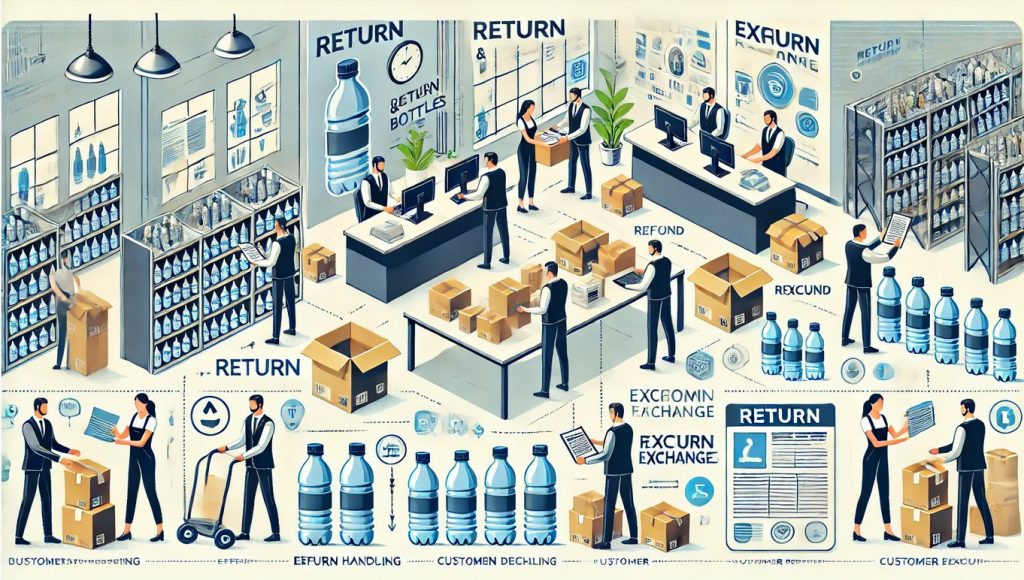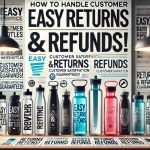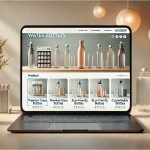The Importance of Handling Returns and Exchanges
In any business, handling returns and exchanges efficiently is essential for maintaining customer satisfaction and loyalty. The water bottle industry, with its diverse range of materials, designs, and customizations, is no exception. Whether it’s a faulty product, a shipping error, or a customer who simply changed their mind, a well-organized returns and exchanges process can enhance customer relationships and improve your brand’s reputation.
Water bottles are often used in various settings like offices, gyms, outdoor adventures, or as personalized gifts, which increases the likelihood of returns. Managing these returns with transparency and efficiency helps minimize operational disruptions while reinforcing trust with your customers. If handled poorly, returns can lead to dissatisfaction, negative reviews, and loss of business.
Setting Clear Return and Exchange Policies
Crafting a Customer-Friendly Return and Exchange Policy
The first step in managing returns and exchanges effectively is creating a clear, customer-friendly policy. Your policy should outline the terms and conditions under which a return or exchange will be accepted, how the process will work, and the timeframe for returns. This ensures transparency and prevents confusion, which could otherwise lead to disputes.
A good return policy for water bottles should include details such as:
- Eligibility for returns or exchanges: Define whether customers can return opened products or only unopened ones, especially for personalized or customized bottles.
- Time frame: Specify the time limit within which returns or exchanges are accepted (e.g., 30 days from the date of purchase).
- Condition of the product: State if the water bottles should be unused, unopened, or in the same condition as when they were sold.
- Proof of purchase: Indicate that customers will need a receipt or order confirmation for returns or exchanges to be processed.
- Shipping costs for returns: Decide whether customers will bear the return shipping costs or if your business will cover these expenses.
- Refund or store credit: Outline whether customers will receive a refund, exchange, or store credit in case of a return.
Having this policy prominently displayed on your website, on product pages, and on invoices will minimize misunderstandings and help you manage customer expectations.
Considerations for Custom or Personalized Water Bottles
When dealing with customized water bottles—whether engraved with names, logos, or specific designs—handling returns can be trickier. Generally, customized or personalized items are non-refundable unless they are defective. However, offering an exception clause for cases where the product is flawed or the personalization was done incorrectly (e.g., misspelling) can help build goodwill.
You can include a statement in your policy that outlines these conditions, such as: “Custom products are not eligible for returns unless there is an error in personalization or a manufacturing defect.”
Offering a Satisfaction Guarantee
A customer satisfaction guarantee can also ease the returns process. Promising that your business will work to make customers happy—whether by replacing a faulty bottle, offering a full refund, or even providing a discount on a future purchase—helps foster trust. A guarantee can differentiate your brand from competitors and reduce the likelihood of returns by reinforcing that you stand behind your products.
Communicating the Returns and Exchanges Process
Providing Clear Instructions
Once your return and exchange policy is established, it’s crucial to communicate the process clearly to your customers. Make sure they know exactly how to initiate a return or exchange and what steps they need to take. Detailed instructions should include:
- How to request a return or exchange: This could involve submitting a return request through your website, contacting customer service via email or phone, or filling out a return form included with the order.
- Return authorization (RMA) number: Some businesses require a Return Merchandise Authorization (RMA) number to process returns. This number can help streamline returns and ensure products are tracked properly.
- Packaging instructions: Explain how to properly pack the water bottles for return. For example, customers should be advised to include the original packaging and ensure the bottle is securely packed to avoid damage during return shipping.
- Return shipping label: If your company provides a pre-paid return label, include the label with the shipment. If customers are responsible for return shipping, make sure they are informed about how to obtain a label.
Setting Expectations for Processing Times
It’s important to inform customers about the expected time frame for processing returns and exchanges. Let them know when they can expect a confirmation of the return, when their refund or replacement will be issued, and how long it might take for them to receive their money back or replacement product. Setting realistic expectations avoids frustration and keeps customers informed throughout the process.
Communicating with Customers Throughout the Process
Clear communication is key when handling returns. Keep customers informed at each step of the process:
- Acknowledgment: Once a return request is received, send a confirmation email to the customer, acknowledging their request and providing next steps.
- Updates: Notify customers when their return is processed, when their refund is issued, or when their replacement product has been shipped.
- Resolution: If the return cannot be completed (e.g., due to a breach in the return policy), explain why and offer alternative solutions, such as a discount or credit on their next purchase.
By keeping customers informed, you help alleviate any potential confusion and ensure that the process goes smoothly.
Managing Defective Water Bottles
Identifying Manufacturing Defects
Manufacturing defects are one of the most common reasons for returns, especially in the case of reusable water bottles. A defective bottle could be one that has cracks, leaks, or faulty lids. To streamline the return process, your business should establish a clear procedure for handling defective products.
Verification and Documentation of Defective Items
When a customer reports a defect, you may ask for photos or videos of the product to assess the issue. This helps verify the defect and avoids fraudulent returns. For example, if the customer claims the water bottle is leaking, a photo of the defect can help you determine whether it’s a manufacturing flaw or user error.
If the bottle is defective, offer to either replace the product or provide a refund. In many cases, offering a replacement item is the best option, as it resolves the issue without the need for a refund.
Offering Refunds vs. Replacements
When dealing with defective products, decide whether to offer a refund or a replacement. Ideally, you should try to offer a replacement first, as this keeps the customer engaged with your brand and avoids a lost sale. However, if the customer prefers a refund or the product is no longer in stock, a full refund should be provided.
To handle defective items efficiently, it’s essential to track returns based on the defect type. You can use this data to improve product quality and make adjustments to your manufacturing or quality control processes. Tracking common defects can help identify recurring issues that may need to be addressed at the production level.
Customer Service During Returns and Exchanges
Offering Personalized Support
Returns and exchanges are often stressful for customers, so offering personalized customer support can turn a potentially negative experience into a positive one. Assigning a customer service representative to handle the return can provide the customer with a direct point of contact and personalized updates on their return status. This approach not only resolves issues more efficiently but also builds stronger relationships with customers.
Handling Difficult Customers
In some cases, returns and exchanges can lead to difficult situations, such as customers who are unhappy with the outcome, have unrealistic expectations, or have experienced repeated issues with your products. It’s important to handle these situations with patience, empathy, and professionalism. Focus on listening to the customer’s concerns, acknowledging their frustration, and offering solutions that align with your company’s policies while still making the customer feel valued.
Training Your Customer Service Team
Properly training your customer service team to handle returns and exchanges is vital. Ensure that your team members are well-versed in your return policies, common product issues, and how to handle customer complaints. A well-trained team can diffuse tense situations and provide swift resolutions, improving overall customer satisfaction.
Managing Refunds and Store Credits
Determining Refund Options
When a customer returns a water bottle for a refund, businesses need to decide the method of refund. This can include:
- Credit card refunds: For customers who made the purchase with a credit card, the refund can be processed directly to the same card.
- Store credit: Some businesses offer store credit instead of a refund, especially for opened or personalized items. Store credit can encourage customers to make a new purchase, but you should be transparent about this option upfront in your return policy.
- Alternative solutions: In some cases, offering a partial refund, discount, or free replacement can be an acceptable compromise, especially if the customer is open to it.
The process of issuing refunds should be as smooth as possible. Once a return is approved, the refund should be processed promptly, and the customer should receive an email confirming the refund has been initiated.
Automating Refunds
Automating the refund process can reduce the workload on customer service teams and streamline the returns experience. Integrating refund processes into your order management system can trigger automatic refunds once the return is approved, improving operational efficiency and reducing human error.
Preventing Future Returns
Collecting Feedback from Customers
While returns are inevitable in any business, collecting feedback from customers can provide valuable insights into why customers are returning products and help you identify areas for improvement. You can include a short survey in the return process asking customers why they decided to return their water bottle, whether it was defective, and what would have made their experience better.
Analyzing Return Patterns
Look for patterns in returns and exchanges. For instance, if you notice a high rate of returns for a particular model of water bottle, it may indicate an issue with product design, quality, or shipping. By addressing these root causes, you can minimize future returns and improve customer satisfaction.
Offering Product Education
Educating your customers on proper usage, care instructions, and cleaning methods for your water bottles can also help reduce returns. If customers know how to properly use and maintain their bottles, they may be less likely to experience issues that would prompt a return.







